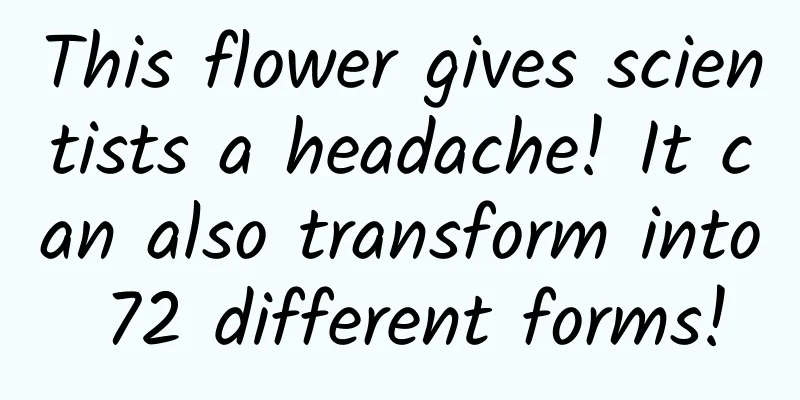This flower gives scientists a headache! It can also transform into 72 different forms!

|
"Seventy-two Transformations" is one of the classic magic spells of Sun Wukong in the Chinese classic "Journey to the West". With this skill, one can transform into seventy-two different forms and have all kinds of forms under control. In real life, it is impossible for mortals like us to perform 72 transformations, but silent plants can achieve it. For example, the protagonist of autumn flowers, the chrysanthemum , has the ability to perform 72 transformations or even thousands of changes. Chrysanthemum (flat petal type) (Photo credit: Zhang Yongkuan) At present, there are about 30,000 varieties of chrysanthemum in the world, and China has more than 3,000 varieties . The peculiarities of variety variation, the diversity of variation types, and the large number of varieties are the most among cultivated plants. In other words, although they are all chrysanthemums, you can appreciate their tens of thousands of different appearances. For chrysanthemums, "transformation" is a piece of cake! Chrysanthemum (Spoon-petaled type) (Photo credit: Zhang Yongkuan) 01 This chrysanthemum is not that chrysanthemum? Don't confuse them Before we start appreciating the chrysanthemum's "transformation", let us first get to know the chrysanthemum. Chrysanthemum (Chrysanthemum×morifolium) is one of the top ten traditional famous flowers in my country. It grows in the large family of Compositae and belongs to the small family of Chrysanthemum. China is the hometown of chrysanthemum , which mainly originates from the middle reaches of the Yangtze River - Hubei, Anhui, Henan and other places. It has a 3,000-year history of documented records in China and more than 1,600 years of artificial cultivation history. It is a flower deeply loved by the people and is also the protagonist of flower shows across China in autumn. Chrysanthemum (tubular type) (Photo credit: Zhang Yongkuan) (Note: All chrysanthemum varieties in this article are from the Chrysanthemum Germplasm Resource Garden of Wuhan Botanical Garden) Chrysanthemum (Osmanthus fragrans) (Photo credit: Zhang Yongkuan) Chrysanthemum (abnormal petals) (Photo credit: Zhang Yongkuan) It is worth reminding that there are many plants with the word "ju" in their names, such as daisy, cosmos, dahlia, marigold, cineraria, etc. However, these Asteraceae plants with the word "ju" in their names are not the same as the traditional famous flower chrysanthemum native to my country. Although they all come from the large family of Asteraceae, they belong to different small families and have different hometowns. For example, daisy belongs to the genus Bellis, native to Europe; cosmos, dahlia, and marigold belong to the genus Anemone, dahlia, and marigold, respectively, all native to Mexico; cineraria belongs to the genus Cineraria, native to the Canary Islands in the Atlantic Ocean . In short, although they all belong to the Asteraceae family and have the word "chrysanthemum" in their names, they are by no means the same. Daisy (copyright image, unauthorized reproduction) Cosmos (copyright image from the gallery, unauthorized reproduction) 02 What did the ancestor of the chrysanthemum, which has “72 transformations”, look like? Sun Wukong's "72 transformations" are all derived from his own transformations. So who is the ancestor of the chrysanthemum, which has so many varieties and ever-changing forms? How did the chrysanthemum gradually evolve into its current appearance over the course of history? Don’t be impatient, let’s talk about the origin of chrysanthemum. The biggest difference between chrysanthemum and other cultivated plants is that many cultivated plants can find similar species in the wild, while chrysanthemum is very different from wild species of the same genus , and direct wild species cannot be found in nature. Due to long-term artificial cultivation and directional selection, the evolution rate of chrysanthemum is much faster than that under natural conditions. Many changes in traits have been clearly different from the original wild species, and some are even "completely unrecognizable." This situation makes the question of the origin of chrysanthemum very complicated, leaving the world with an unsolved mystery for thousands of years. In recent decades, through the unremitting efforts of scientists, the origin of chrysanthemum has not yet been determined, but some preliminary clues have been found. It turns out that the origin of chrysanthemum is not from a single wild species, but from different species in the Asteraceae family. Studies have shown that the main species are Chrysanthemum vestitum, Chrysanthemum indicum, Chrysanthemum lavandulifolium and other Chrysanthemum plants. It is generally believed in academia that chrysanthemum (Chrysanthemum×morifolium) is a "cultivated hybrid complex" formed by natural interspecific hybridization of these different wild species and then artificial selection. Hairy Chrysanthemum (Photo source: China Plant Image Library) Wild chrysanthemum (Photo source: China Plant Image Library) Chamomile (Photo source: China Plant Image Library) 03 Innate talent plus acquired help Achieve the ever-changing chrysanthemum In other words, the ancestors of chrysanthemums were just some inconspicuous wild flowers, but now they have developed into so many varieties and variants, which has become a miracle of modern flower breeding. Why are there so many varieties of chrysanthemums? In the novel, Sun Wukong is gifted and has a powerful master who teaches him how to transform into seventy-two different forms. The same is true for chrysanthemums. The reasons for their ever-changing forms include both internal and external factors. Let me explain. First of all, chrysanthemum itself has a strong ability to mutate. Chrysanthemum is a naturally cross-pollinated plant. This natural hybridization characteristic makes each individual plant of its offspring have a different genetic composition, which is also the main reason why chrysanthemums have such a wide variety of shapes. In addition, there is no strict reproductive isolation between species of Chrysanthemum . In other words, it is easier for different species to hybridize and produce interspecific hybrids. On the one hand, its active evolutionary process brings difficulties to the study of the origin of chrysanthemum, but at the same time, it is this richness that has laid the genetic foundation for today's diverse chrysanthemum varieties. At the same time, cultivated chrysanthemums are also very prone to bud mutations (bud mutations: somatic mutations occurring in the buds or branches of a plant), further enriching the sources of chrysanthemum variation selection. Based on the characteristics of chrysanthemum itself, humans have also carried out purposeful selection and cultivation of chrysanthemum . The rich variation of chrysanthemums has been preserved thanks to the hardworking and intelligent Chinese people. Since Tao Yuanming of the Eastern Jin Dynasty, chrysanthemums have been planted in courtyards as ornamental flowers. Since then, people have carefully cultivated chrysanthemums and accumulated experience in chrysanthemum planting techniques. The technology of planting chrysanthemums continued to improve in the Tang Dynasty. The sentence in Guo Tuotuo's "The Book of Planting Trees" "Remove one side of the skin of the yellow and white chrysanthemums, tie them together with jute skin, and the flowers will be half yellow and half white" shows that people have mastered the technology of grafting chrysanthemums. In the Song Dynasty, a monograph on chrysanthemum, namely "Chrysanthemum Book", appeared. Fan Chengda believed in "Chrysanthemum Book" that "with hard work and fertile soil, the flowers can change frequently." Shi Zhengzhi said in "Chrysanthemum Book" that "I planted more than a hundred large white chrysanthemums in Sanshui, and they all turned into yellow the following year." These records describe that the natural variation of chrysanthemums is related to environmental conditions, and also show that people have realized that planting chrysanthemums in fertile soil and weeding them at the right time can promote their variation and thus breed new varieties. During the Ming and Qing Dynasties, the level of chrysanthemum cultivation was further improved, and new breakthroughs were made in chrysanthemum varieties. The Qing Dynasty produced the most monographs on chrysanthemums in Chinese history . With Beijing as the center, from the palace to the urban and rural folks, raising and appreciating chrysanthemums became a popular trend in the capital, and a complete system of chrysanthemum cultivation theory and technology had been initially formed. Chrysanthemum varieties described in Mr. Ding Lianfeng's Chrysanthemum Album in the Qing Dynasty (Image source: Wang Zifan's "Horticultural Research on Ancient Chinese Chrysanthemum Catalogue") To sum up, although the original ancestor of chrysanthemum looks inconspicuous, the chrysanthemum family is naturally endowed with a strong ability to mutate. After long-term and careful cultivation by gardeners and enthusiasts , it has developed into the most diverse cultivated plants in the world. 04 Technology helps "transformation" Chrysanthemum breeding has a promising future At present, chrysanthemum has developed into one of the four major cut flowers in the world and plays a very important role in the flower industry. At the same time, chrysanthemum is an important flower in garden applications, often used in potted plants, flower beds and ground cover planting, and is deeply loved by people all over the world. Therefore, continuously selecting and cultivating new varieties with excellent and unique traits plays a great role in improving the ornamental value and economic value of chrysanthemum. With the development of science and technology, the continuous progress of modern breeding technology has made it possible to cultivate new varieties of chrysanthemums. I believe that with the help of science and technology, chrysanthemum varieties will continue to keep pace with the times, and chrysanthemums will continue to have new and wonderful "transformations". Author: Zhang Fan, Wuhan Botanical Garden, Chinese Academy of Sciences References: [1] Dai Silan, Chen Junyu. Cladistic taxonomy of some species of Chrysanthemum in China [J]. Wuhan Botanical Research, 1997, 15(1): 27-34. [2] Dai Silan, Chen Junyu, Li Wenbin. RAPD analysis of the origin of chrysanthemum[J]. Acta Botanica Sinica, 1998, 40(11): 1053-1059. [3] Tang Dai, Xiong Jihua, Wang Shiyu. Discussion on the issues of cut chrysanthemum breeding[J]. Journal of Yunnan Agricultural University, 2001(01):46-49 [4] Dai Silan, Wang Wenkui, Huang Jiaping. Research progress on Chrysanthemum systematics and origin of chrysanthemum[J]. Journal of Beijing Forestry University, 2002(24):230-234. [5] Chen Yunluan. Research on the cultivation of chrysanthemum and its economic and cultural value in ancient my country[D]. Nanjing Agricultural University, 2008. [6] Wang Zifan. Horticultural Research on Ancient Chinese Chrysanthemum Catalogue[D]. Beijing Forestry University, 2010. [7] Dai Silan. The charm of Chinese chrysanthemums[J]. Chinese Garden, 2012(08):46-48. [8] Zhu Xiangzhen. A brief analysis of the prospects for chrysanthemum cultivation[J]. Modern Horticulture, 2017, (06): 20 [9] Luo Yuting. Establishment of genetic transformation system of potted chrysanthemum and transformation of chrysanthemum with blue gene[D]. Nanjing Agricultural University, 2019. Source: China Science Expo This article is produced by Science Popularization China and supervised by the Computer Network Information Center of the Chinese Academy of Sciences The cover image and the images in this article are from the copyright gallery. The image content is not authorized for reprinting. |
<<: Weird! Watermelon has grown bean sprouts
>>: What's a week of constipation? It can be "constipated" for a whole year!
Recommend
How to play with your own nipples to feel good? How to play with nipples comfortably?
How to pinch and how to make it feel good? ? Plea...
How many ants are there on Earth? Scientists have finally counted them!
Ants are a common insect, but how many ants are t...
What new applications does the “dream material” graphyne have in the field of electrochemistry?
Produced by: Science Popularization China Author:...
Use an article to help you understand the interactive design methodology "Progressive Disclosure"
Hello everyone, I’m Clippp. Today I’m going to sh...
[Smart Agriculture Diagram] One picture reveals the secret! How safe are genetically modified foods?
...
Some security issues in Android development: Activity
1. The activities used within this app must be se...
91 Ten Articles: Tesla raises prices in the US and China simultaneously, Wuling Hongguang will no longer be able to get a Shanghai license plate
1. Tesla Model 3 and Model Y have raised prices a...
Can anyone tell me what the relationship is between the stir-fried rapeseed and the rapeseed flowers on my plate?
Winter has gone and spring has arrived. Under the...
Cook: The tech industry is obsessed with success, and this is a disease
[[129910]] Jobs hopes that Apple will create grea...
Increase fans! 6 practical ways to increase followers, I will teach you all of them today!
I have summarized 6 effective ways to increase fo...
Product creation and verification operations for Douyin local life services
Douyin’s local life service makes targeted invita...
"Physical Store Live Broadcasting Customer Development Operation Manual" Master the physical store customer development traffic code with zero basic knowledge
Introduction to the training course content: 2022...
The Big Jump World Cup is about to start, Shougang's "Snow Flying Sky" starts making snow! Why use "ice-like snow"?
The 2023/2024 FIS Snowboard and Freestyle Skiing ...
Surgery without anesthesia, life without anxiety, rare gene mutations inspire new medicine
The easiest pain to bear is someone else's. —...
Li Mengchao interprets Karen: Talk to your inner child to resolve inner conflicts
Li Mengchao interprets Karen: Talk to your inner ...









